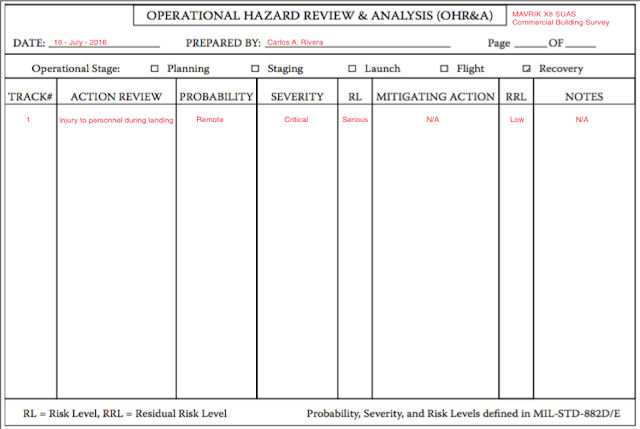The Small Unmanned Air
System (SUAS) selected for analysis is the Mavrik X8 quad rotor SUAS developed
by SteadiDrone. This particular SUAS was
designed around its front mounted gimbal to provide unobstructed imagery. The designers are targeting the aerial
imaging industry and have developed a SUAS that is capable and economical. One of the advantages of this particular SUAS
is its ability to fold away for transport in a lightweight case. Operation of this SUAS for commercial
applications require the development of an Operational Risk Management (ORM)
program. The purpose of the ORM is to
identify hazards that are associated with operation of the SUAS. Assessments are performed to identify the
level of risk and determine if the mission falls within acceptable and
established safety limits. The
Department of Defense (DoD) established a standard practice for the evaluation
of risks. MIL-STD-882 is utilized to
identify the “DoD approach for identifying hazards and assessing and mitigating
associated risks encountered in the development, test, production, use, and
disposal of defense system” (Department of Defense, 2012) .
The first step in the
creation of an ORM is the development of Preliminary Hazard Lists (PHL). Physical characteristics of the SUAS must be
evaluated and thoroughly understood in order to develop the required PHL. Figure
1 illustrates the dimensions and operations specifications of the
SUAS. The different PHL capture the
identified hazards during each stage of the operation; in this case the stages
are: planning, staging, launch, flight, and recovery. Each evaluation was performed through
analysis and discussion of the associated dangers with operation of the SUAS
during a commercial building survey. The
PHLs covered man, machine, method, and environment. Figures 2 through 6 cover the PHL for each of
the stages of operation of the Mavrik X8 SUAS.
Figure 1. Dimensions and operation
specifications of Mavrik X8 SUAS.
Retrieved from https://drive.google.com/file/d/0B1zbGeuC_WU5cX V4Y0VPVzM0YkE
/view?pref=2&pli=1
Preliminary
Hazard List (PHL)
Figure 2. Planning PHL.
Figure 3. Staging PHL.
Figure 4. Launch PHL.
Figure 5. Flight PHL.
Figure 6. Recovery PHL.
Operational Hazard Review
and Analysis
The purpose of the Operational
Hazard Review and Analysis (OHR&A) is to further identify and evaluate the
hazards associated with the SUAS operation.
It takes the analysis from the PHL and further looks at the mitigating
actions identified to address risk. Each
of these actions is further evaluated to determine if they were adequate or if
further actions are needed to reduce/eliminate risk. Figures 7 though 11 cover the OHR&A for
each stage of the operation of the Mavrik X8 SUAS.
Figure 7. Planning OHR&A
Figure 8. Staging OHR&A
Figure 9. Launch OHR&A
Figure 10. Flight OHR&A
Figure 11. Recovery OHR&A
Operational
Risk Management (ORM) Tool
The ORM tool is the culmination of risk
analysis for a particular operation. Its
purpose is to provide an easy to use and understand method to evaluate the
level of risk with a particular operation.
The tool is divided in the different type of missions for the SUAS
including training, check flights, revenue flights, and experimental
flights. Each type of flight carries a
different level of risk, which is evaluated in each respective category of
operaitons including planning, staging, launch, flight, and recovery. The ORM for the Mavrik X8 is illustrated in Figure 12.
Figure 12. ORM tool for Mavrik X8.
References
Barnhart, R. K. (2012). Introduction to unmanned
aircraft systems. Boca Raton: Taylor & Francis.
Department of Defense. (2012, May 11).
MIL-STD-882E. Retrieved from system-safety.org:
http://www.system-safety.org/Documents/MIL-STD-882E.pdf
SteadiDrone. (2016). Mavrik X8
Overview. Retrieved from drive.google.com: https://drive. google.com/file/d/0B1zbGeuC_WU5cXV4Y0VPVzM0YkE/view?pref=2&pli=1












Post a Comment